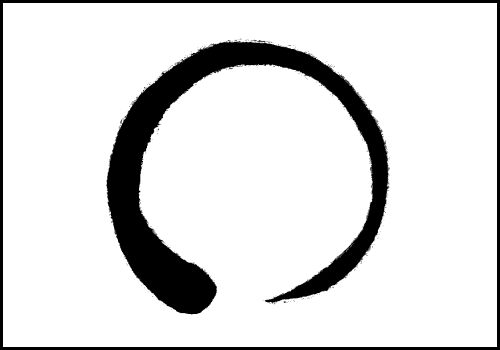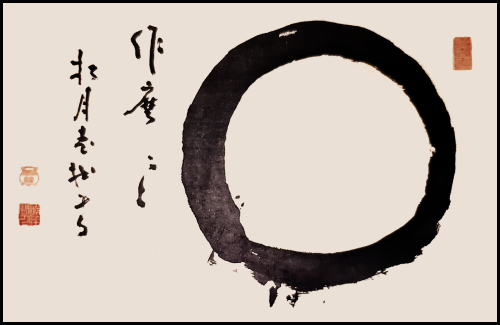Ensô 円相 – the Circle
On this homepage one will time and again see a little picture with only a circle drawn on it – in this case it’s a black circle which is not totally closed, not completed yet. This very basic symbol is called ensô 円相 (circle, round + appearance = something shaped roundly). Some persons possibly know this subject from some pictures or picture scrolls, already. In the Western world, at least that’s what I’m really convinced of, it became primarily known in the second half of the last century in conjunction with zen meditation, the japanese calligraphy known as shodô and the movement art aikidô, likewise of Japanese origin.
At this point I don’t want to assume any mandatory explanation of what exactly the symbol ensô does represent or absolutely doesn’t. I don’t even know which of the numerous explanations one can find corresponding to pictures of that kind are extraordinarily good. Therefore, at first I will subsequently describe what ensô does mean to me personally and why I’ve chosen to use it for the aforementioned little picture – at this place here simply utilized for functioning merely as a spacer – quite consciously .
The circle should be drawn with one stroke while breathing out. Essentially later correction isn’t possible. It can be closed or open-worked, still being not completed. I personally really like the idea that a thing isn’t particular special despite but precisely because of its imperfection.
In Japan there exists a craftsmanship which in my opinion is an expression of this kind of mindset: kintsugi 金継ぎ (金 = Gold + 継ぎ = to connect, thus to join something by using gold). Here, with an adhesive to which gold or the like has been admixed, a shattered pottery is purposely put together again in such a way that one can still clearly recognize the old fractures.*

a simple yet very powerful symbol
In my eyes, the open circle symbolizes e.g. the circular flow of learning and experiencing, well even the flow of life itself, too. The brushstroke hasn’t reached its end yet, thus there’s still always something new to learn and experience. I’m not sure about life but with regard to learning even closing the circle wouldn’t be an end but a new beginning, this time on a somewhat higher level. Would one draw a new circle above the old one with a brush, still the new pigments would be atop those of the first circle and this way it would go on spirally with every new circle. When one is engaged in things, does master them and when still seriously engages oneself in them, on the base of the knowledge and the experience already gained, maybe one can again get totally new insights which will possibly stay closed to others.
If we stay by a single (open) circle to keep it simple, it stimulates, too. It epitomizes that – no matter how slow one may advance maybe – every single step will unavoidedly take us closer to our goal. In case one’s heading in a completely wrong direction, perhaps the circle will become slightly noncircular. Certainly I could demonstrate many further thoughts that do come to mind when I think about circles but instead of that I will now let others explain what the circle means in Japanese culture, especially in zen buddhism.

In Chinese and Japanese systems of moral education or those countries’ martial arts, there is often talk of the way (chin. dào 道, jap. dô 道). Out of Japan do come the modern martial arts kendô 剣道 (sword-way, the sportive fencing for point scores with bamboo swords) and jûdô 柔道 (flexible-way) but of the already mentioned shodô 書道 (handwriting/letter-way/teaching) and chadô 茶道 (tea-way), too.
The simple translation of dô as way holds the problem that one misses the big complexity which comes along with that term. At this point this complexity will not be specifically addressed but it should be noted that at least in my opinion the way must be seen as a spiritual superstructure which in each case provides the individual doctrines with a specific framework.
Naturally, the famous zen master Dôgen Zenji (道元 禅師, 1200-1253) also talked about the way,** those linearity he by all means accepted (one concentrates on working towards a goal which is far away and progresses on the chosen way). Even so he talks as well about the way as a ring, dôkan (道環 way-ring) or more precisely about the gyôji-dôkan 行持道環 (the contextual meaning is approximately: 行持 to engage continuously in the [buddh.] practice + 道環 rotating on the [buddh.] way).
In his eyes each moment of practice also contains enlightenment and every moment of enlightenment contains practice; the process of practice and the goal are inseparable. With each step one takes, one also arrives and moment after moment the circle of practice and enlightenment is renewed. One doesn’t walk towards enlightenment but enlightenment unfolds.
In a zen dicitionary (I don’t know its English title as only a copy of the relevant entry was leaked to me, unfortunately) it says on page 248 under ichi-ensô 一円相: “Literally “one round shape.” This refers to ultimate reality that encompasses the whole universe perfectly. cf. Hekigan-roku, 69.”
According to Daisetz T. Suzuki the hekigan-roku 碧巌録 (blue rocks records),*** often translated as “records of the blue cliffs”, is one of the most important works for studying zen. He writes that this work (obviously of Chinese origin) is used since its introduction in Japan somewhen in the 14th century. In principle,the book consists mainly of one hundred short anecdotes and the commentaries explaining them. It’s the work of chan buddhism, who did then later spread in Japan as zen buddhism.
Interestingly, in the Kashima Shinden Jikishinkage-ryû Seitô-ha, a sword school tradition, there are Suburi 素振り (= “elementary swinging”), which are called ichi-ensô, too. For these overhead strikes, which do actually simulate cuts, a so-called bokutô 木刀 (= “wooden-sword”) is swung alternating above the left and the right shoulder. ****

Ensô, accompied by the phrase “Saku ma、saku ma。”
Already in the foreword of her book “Ensō: Zen Circles of Enlightenment” Audrey Yoshiko Seo did write a few things about the circle as such. Across cultures and throughout ages it’s told to have always evoked a feeling of calm and completeness. The circle is said to express the totality of our being and – no matter if in worship ceremonies, in mythological tales or in religious arts – to point to the most vital aspect of our existence, its ultimate wholeness. Seo remarks that Carl Jung (she undoubtedly thinks of the Swiss Carl Gustav Jung, founder of the analytical psychology, 1875-1961) in his commentaries about our collective unconscious referred to the circle as the “archetype of wholeness”. In addition she states that obviously we’re connected with the circle as we’re embedded in the circularity of the horizon and are living on a sphere that circles around the sun with other spheres.*****
On page 64 of her book Seo writes about the picture seen above (copy of a bad photo found online, slightly processed by me), painted by zen master Chûhô Sôu 宙寶宗宇 (also Shôgetsu 松月), that with his ensô and the inscription he strikes at the heart of zen. Next to the circle he drew the two kanji (characters) saku ma followed by two repeat marks (作 = build, cultivate + 磨く = polish, refine (e.g. an ability), brush). Seo concludes that with “Saku ma、saku ma。” Chûhô Sôu encourages the viewers of his picture to always strive to deepen their skill and training in order to deepen their zen experience and understanding.
– – – – – – – – – – – – – – – – – – – – – – – – – – – – – – – – – – – – – – – – – – – – – – – – – – – – – – – – – –
*Even though one can read very often the statement that while doing kintsugi gold will be added to a glue or something similar to then stick pieces back together, appropriately rather just directly after the agglutination the adhesive surfaces get coated with e.g. gold- or silver-dust, usually.
**Kazuaki Takahashi (Herausgeber), Enlightenment Unfolds: The Essential Teachings of Zen Master Dōgen, 2000, S. xxvii f., Shambhala Publications, Inc.
***Daisetz T. Suzuki, ON THE HEKIGAN ROKU (“Blue Cliff Records”) With a Translation of “Case One”, p.5 in The Eastern Buddhist NEW SERIES, Vol. 1 (September 1965), published by Eastern Buddhist Society
****Grigoris Miliaresis, Kashima Shinden Jikishinkage-ryu: breath in, breath out, step in, step out
(online article) for budojapan.com (by BAB), last checked on thursday., 28.07.2021 20:57pm,
https://budojapan.com/kenjutsu/ksj20201014/
*****Audrey Yoshiko Seo, Ensō: Zen Circles of Enlightenment, 2007, p. xi, Weatherhill Boston & London